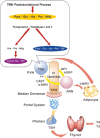NEW INSIGHTS INTO THE HYPOTHALAMIC-PITUITARY-THYROID AXIS
- PMID: 31149076
- PMCID: PMC6535279
- DOI: 10.4183/aeb.2016.125
NEW INSIGHTS INTO THE HYPOTHALAMIC-PITUITARY-THYROID AXIS
Abstract
The discovery of thyrotropin releasing hormone (TRH) in 1969 was the definitive step in decoding the hypothalamic-pituitary thyroid (HPT) axis, thereby opening up the era of neuroendocrinology, while it also revolutionized the diagnostic and therapeutic approach to patients with thyroid diseases. TRH, produced in the hypothalamus, is the central regulator of the HPT. It functions via neurons originating in the paraventricular nucleus (PVN), which integrates multiple neuronal and humoral signals and resets the HPT axis according to variations of external and internal environmental conditions. The TRH activates TSH in the pituitary that stimulates the secretion of thyroxine from thyroid which, in turn, exerts a negative feedback on TSH and TRH secretion. However, various factors are involved in the regulation of the HPT axis. Leptin has both indirect and direct effects on TRH regulation, the former by regulating agouti-related peptide (AGRP) in the arcuate nucleus (ARN) that antagonizes the α-MSH stimulatory activity on pro-TRH gene expression in the PVN, and the latter by stimulating hypothalamic TRH expression, TRH transcription via stimulation of pro-convertase 1 and 2 expression, which lead to enhanced processing of pro-TRH into TRH. The interplay of TRH with leptin and the recently reported influence of ghrelin on the HPT axis can alter the setpoint of the axis. The polyphenol resveratrol, as recently observed, exerts an anxiolytic and antidepressant activity in subclinical hypothyroid (SCH) rats. Resveratrol, by decreasing both TSH and TRH mRNA expression, regulates the HPT axis, while in parallel it regulates the Wnt/β-catenin pathway in the hippocampus. These findings open up possibilities for the therapeutic use of resveratrol as coadjuvant, especially in overt and SCH states marked by anxiety and depression. The clinician should be aware of clinical changes that can invalidate the normal regulation of the HPT axis, the most commonly observed being medications and comorbidities.
Keywords: Hypothalamic-Pituitary Thyroid axis; TRH; TSH; tanycytes.
Conflict of interest statement
The author declares that he has no conflict of interest concerning this article.
Figures


Similar articles
-
Regulation of Thyroid Hormone Levels by Hypothalamic Thyrotropin-Releasing Hormone Neurons.Thyroid. 2023 Jul;33(7):867-876. doi: 10.1089/thy.2023.0173. Epub 2023 Jun 6. Thyroid. 2023. PMID: 37166378 Free PMC article.
-
The Hypothalamic Paraventricular Nucleus Is the Center of the Hypothalamic-Pituitary-Thyroid Axis for Regulating Thyroid Hormone Levels.Thyroid. 2022 Jan;32(1):105-114. doi: 10.1089/thy.2021.0444. Epub 2021 Dec 29. Thyroid. 2022. PMID: 34726513
-
60 YEARS OF NEUROENDOCRINOLOGY: TRH, the first hypophysiotropic releasing hormone isolated: control of the pituitary-thyroid axis.J Endocrinol. 2015 Aug;226(2):T85-T100. doi: 10.1530/JOE-15-0124. Epub 2015 Jun 22. J Endocrinol. 2015. PMID: 26101376 Review.
-
alpha-Melanocyte-stimulating hormone is contained in nerve terminals innervating thyrotropin-releasing hormone-synthesizing neurons in the hypothalamic paraventricular nucleus and prevents fasting-induced suppression of prothyrotropin-releasing hormone gene expression.J Neurosci. 2000 Feb 15;20(4):1550-8. doi: 10.1523/JNEUROSCI.20-04-01550.2000. J Neurosci. 2000. PMID: 10662844 Free PMC article.
-
Feedback regulation of thyrotropin-releasing hormone (TRH): mechanisms for the non-thyroidal illness syndrome.J Endocrinol Invest. 2004;27(6 Suppl):105-19. J Endocrinol Invest. 2004. PMID: 15481810 Review.
Cited by
-
Thyroid testing in acutely ill patients may be an expensive distraction.Biochem Med (Zagreb). 2017 Jun 15;27(2):300-307. doi: 10.11613/BM.2017.033. Biochem Med (Zagreb). 2017. PMID: 28694722 Free PMC article. Review.
-
Intrathyroidal feedforward and feedback network regulating thyroid hormone synthesis and secretion.Front Endocrinol (Lausanne). 2022 Sep 15;13:992883. doi: 10.3389/fendo.2022.992883. eCollection 2022. Front Endocrinol (Lausanne). 2022. PMID: 36187113 Free PMC article. Review.
-
HIGH-SENSITIVITY C-REACTIVE PROTEIN, POSSIBLE BIOMARKER FOR DEPRESSION IN ELDERLY POPULATION.Acta Endocrinol (Buchar). 2019 Apr-Jun;15(2):215-220. doi: 10.4183/aeb.2019.215. Acta Endocrinol (Buchar). 2019. PMID: 31508179 Free PMC article.
References
-
- Guillemin R. Characterization of the thyrotropin releasing factor, now known as thyrotropin releasing hormone. Reminiscences and reflections thirty years later. In: Duntas LH, Guillemin R, editors. Hypothalamic Releasing Hormones. Challenges and Perspectives at the 2000 year mark. Athens: Beta Medical Art; 2000. pp. 7–16.
-
- Burgus R, Dunn RF, Desiderio D, Guillemin R. Stucture moleculaire du facteur hypothalamique hypophysiotrope TRF d’origine ovine: evidence par spectometrie de masse de la seequence PGA-His-Pro-NH2. CR Acad Sci (Paris) 1969;269:1870–1873. - PubMed
-
- Schally AV, Redding TW, Bowers CY, Barett JF. Isolation and properties of porcine thyrotropin-releasing hormone. J Biol Chem. 1969;244:4077–4081. - PubMed
-
- Raisman Geoffrey. 60 years of neuroendocrinology: Memoir: Geoffrey Harris and my brush with his unit. J Endocrinology. 2015;226(2):T1–T11. - PubMed
-
- Yamada M, Saga Y, Shibusawa N, Hirato J, Murakami M, Iwasaki T, Hashimoto K, Satoh T, Wakabayashi K, Taketo MM, Mori M. Tertiary hypothyroidism and hyperglycemia in mice with targeted disruption of the thyrotropin-releasing hormone gene. Proc Natl Acad Sci U S A. 1997;94(20):10862–10867. - PMC - PubMed
LinkOut - more resources
Full Text Sources
Miscellaneous
